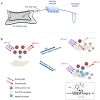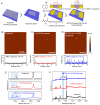Recent advances in nanomaterials for the detection of mycobacterium tuberculosis (Review)
- PMID: 39717951
- PMCID: PMC11722055
- DOI: 10.3892/ijmm.2024.5477
Recent advances in nanomaterials for the detection of mycobacterium tuberculosis (Review)
Abstract
The world's leading infectious disease killer tuberculosis (TB) has >10 million new cases and ~1.5 million mortalities yearly. Effective TB control and management depends on accurate and timely diagnosis to improve treatment, curb transmission and reduce the burden on the medical system. Current clinical diagnostic methods for tuberculosis face the shortcomings of limited accuracy and sensitivity, time consumption and high cost of equipment and reagents. Nanomaterials have markedly enhanced the sensitivity, specificity and speed of TB detection in recent years, owing to their distinctive physical and chemical features. They offer several biomolecular binding sites, enabling the simultaneous identification of multiple TB biomarkers. Biosensors utilizing nanomaterials are often compact, user‑friendly and well‑suited for detecting TB on location and in settings with limited resources. The present review aimed to review the advances that have occurred during the last five years in the application of nanomaterials for TB diagnostics, focusing on their detection capabilities, structures, working principles and the significance of key nanomaterials. The current review addressed the limitations and challenges of nanomaterials‑based TB diagnostics, along with potential solutions.
Keywords: biosensors; diagnostics; nanomaterials; tuberculosis.
Conflict of interest statement
The authors declare that they have no competing interests.
Figures










Similar articles
-
Recent advances in gold nanoparticles-based biosensors for tuberculosis determination.Talanta. 2024 Aug 1;275:126099. doi: 10.1016/j.talanta.2024.126099. Epub 2024 Apr 12. Talanta. 2024. PMID: 38640517 Review.
-
Trends in Diagnosis for Active Tuberculosis Using Nanomaterials.Curr Med Chem. 2019;26(11):1946-1959. doi: 10.2174/0929867325666180912105617. Curr Med Chem. 2019. PMID: 30207212 Review.
-
Label-free nano-biosensing on the road to tuberculosis detection.Biosens Bioelectron. 2018 Aug 15;113:124-135. doi: 10.1016/j.bios.2018.04.059. Epub 2018 May 1. Biosens Bioelectron. 2018. PMID: 29754051 Review.
-
Advances on Electrochemiluminescent Biosensors for TB Biomarkers.ACS Sens. 2025 Apr 25;10(4):2409-2430. doi: 10.1021/acssensors.4c03517. Epub 2025 Apr 9. ACS Sens. 2025. PMID: 40202785 Free PMC article. Review.
-
Nano-biosensing approaches on tuberculosis: Defy of aptamers.Biosens Bioelectron. 2018 Oct 15;117:319-331. doi: 10.1016/j.bios.2018.06.025. Epub 2018 Jun 11. Biosens Bioelectron. 2018. PMID: 29933223 Review.
Cited by
-
Zoonotic Tuberculosis and Dairy Products: Comprehensive Meta-Analysis of Prevalence and Public Health Implications.Vet Med Sci. 2025 Sep;11(5):e70556. doi: 10.1002/vms3.70556. Vet Med Sci. 2025. PMID: 40788195 Free PMC article. Review.
-
Targeting cuproptosis opens a new chapter of nanomedicine: a scientometric and graphical analysis.Naunyn Schmiedebergs Arch Pharmacol. 2025 Aug 12. doi: 10.1007/s00210-025-04497-x. Online ahead of print. Naunyn Schmiedebergs Arch Pharmacol. 2025. PMID: 40794178
-
Unlocking the mitochondrial functional code: unraveling the pathogenesis of ovarian cancer and innovative targets to inhibit malignant behavior.J Transl Med. 2025 Jul 24;23(1):819. doi: 10.1186/s12967-025-06840-5. J Transl Med. 2025. PMID: 40707948 Free PMC article. Review.
-
Electrochemical Impedance Spectroscopy-Based Biosensors for Label-Free Detection of Pathogens.Biosensors (Basel). 2025 Jul 10;15(7):443. doi: 10.3390/bios15070443. Biosensors (Basel). 2025. PMID: 40710093 Free PMC article. Review.
References
-
- Asadi L, Croxen M, Heffernan C, Dhillon M, Paulsen C, Egedahl ML, Tyrrell G, Doroshenko A, Long R. How much do smear-negative patients really contribute to tuberculosis transmissions? Re-examining an old question with new tools. EClinicalMedicine. 2022;43:101250. doi: 10.1016/j.eclinm.2021.101250. - DOI - PMC - PubMed
Publication types
MeSH terms
Substances
LinkOut - more resources
Full Text Sources
Medical
